brakes AUDI A5 COUPE 2011 Owners Manual
[x] Cancel search | Manufacturer: AUDI, Model Year: 2011, Model line: A5 COUPE, Model: AUDI A5 COUPE 2011Pages: 362, PDF Size: 84.88 MB
Page 18 of 362
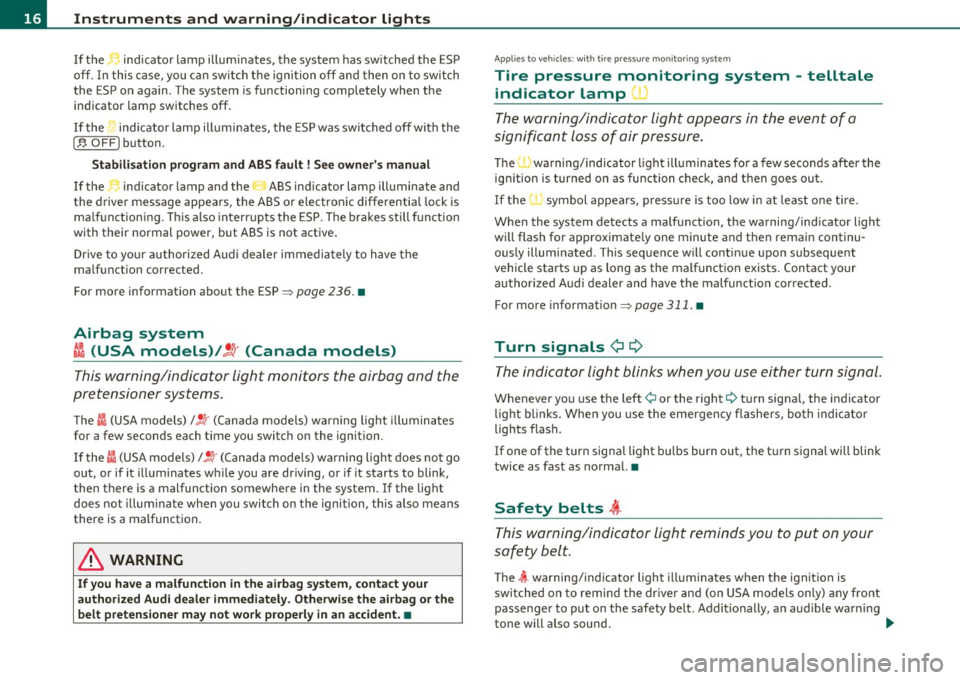
Instruments and warning /indicator lights
If the • indicator lamp illuminates, the system has switched the ESP
off. In this case , yo u ca n swi tch the ignition off and then on to switch
the ESP on again. The system is functioning completely when the
ind icator lamp switches off.
If the • ind icator lamp illuminates, the ESP was switched off wi th the
[,$ OFF) button.
S tabili sation p rogra m and ABS faul t ! See owner' s m anual
If the indicator lamp and the ABS ind icator lamp illuminate and
the driver message appears, the ABS or e lectronic differentia l lock is
ma lfunction ing. This also interrupts the ESP. The brakes still function
with their normal power, but ABS is not active .
Drive to your authorized Audi dealer immedia tely to have the
ma lfunction corrected.
For more information abo ut the ESP=>
page 236. •
Airbag system
~i (USA models) /!l (Canada models)
This warning/indicator light monitors the airbag and the
pretensioner systems.
T he Cl (USA models) l! !r (Canada mode ls) wa rning light illuminates
for a few seconds each time you switch on the ignition .
If the
I (USA models)/ !~· (Canada mode ls) warning light does not go
out, or if it illuminates while you are driving, or if it starts to blink ,
then there is a malfunction somewhere in the system. If the light
does not illum inate when you switch on the ignition, this also means
there is a malfunction .
& WARNING
If you have a malfuncti on in the airbag s ystem , cont act your
authorized Aud i dealer imm ediately. Otherw ise the airbag or the
belt pretensioner m ay n ot wo rk properly in an accident. •
App lies to veh icles: with t ire p ress ure mon it o ring sys tem
Tire pressure monitoring system -telltale
indicator lamp '
The warning/indicator light appears in the event of a
significant loss of air pressure.
The 'warning/indicator light illuminates for a few seconds after the
ignition is turned on as function check, and then goes out .
If the ' \symbol appears, p ress ure is too low i n at least one t ire.
When the system detects a malfunction, the warning/ind icator light
w ill flash for approximate ly one minute and then rema in continu
ously illuminated . This seque nce w ill co ntinue upo n subsequent
vehicle starts up as long as the ma lf u nctio n exists. Contact yo ur
au thor ized A udi dealer and have the malfunct ion corrected.
For more information=>
page 311. •
Turn signals ¢¢
The indicator light blinks when you use either turn signal .
Whenever you use the left¢ or the right¢ turn signa l, the indicator
light bl inks. When you use the eme rgency flashers, bo th indicato r
lights flash .
If one of the turn signa l light bu lbs burn out , the t urn signal will blink
twice as fast as normal. •
Safety belts ,i
This warning/indicator light reminds you to put on your
safety belt.
The ~ warning/indicator light illum inates when the ignit ion is
switched on to remind the dr ive r and (on USA mode ls only) any fron t
passenger to put on the safety belt. Additionally, a n audible warn ing
tone will also sound . _.,,
Page 20 of 362
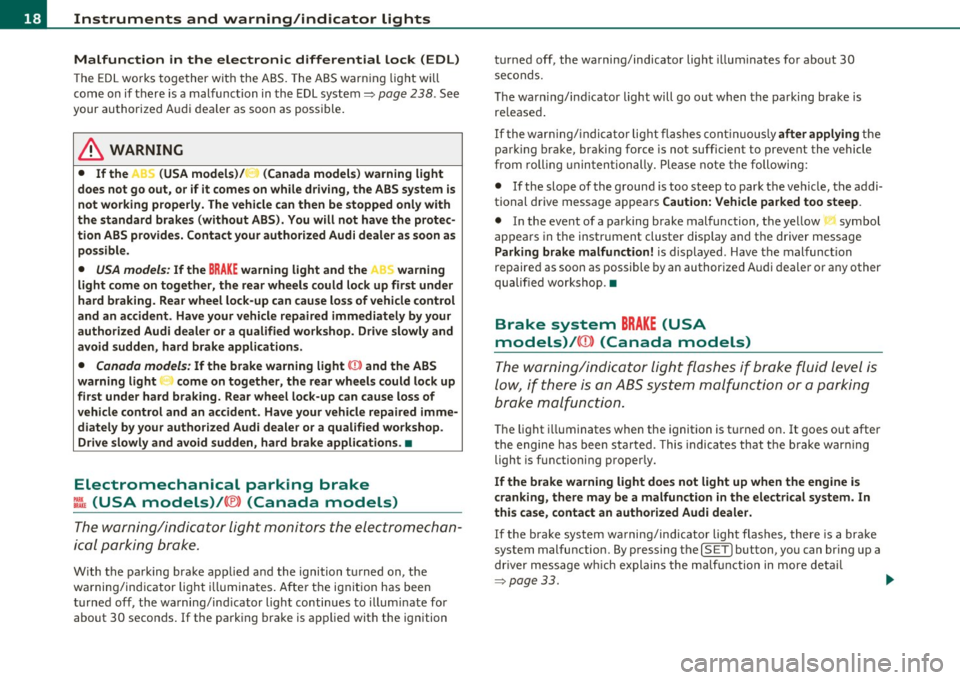
Instruments and warning/indicator lights
Malfunction in the electronic differential lock (EDL)
The ED L works toge ther w ith the ABS. The ABS warn ing lig ht w ill
come on if there is a mal func tion in the EDL system=>
page 238 . See
your authorized A udi dea le r as soon as poss ible .
& WARNING
• If the .. (USA models )/ ...,. (Canada models ) wa rning light
does not go out , or if it comes on while driving, the ABS system is
not working properly. The vehicle can then be stopped only with
the standard brakes (without ABS ). You will not have the p rotec
tion ABS provides. Contact your authorized Audi dealer a s soon as
pos sible.
• USA models : If the BRAKE warning light and the M, warning
light come on together, the rear wheels could lock up fir st under
hard braking. Rea r wheel lock-up can cause loss of vehicle cont rol
and an accident . Have your vehicle repaired immediately by your
autho rized Audi dealer or a qualified work shop. Dri ve slowly and
avoid sudden, hard brake applications.
• Canada models: If the brake warning light 0 and the ABS
warning light come on together, the rear wheels could lock up
first under hard braking. Rear wheel lock -up can cause loss of
vehicle control and an accident . Have your vehicle repaired imme
diately by you r authorized Audi dealer or a qualified wo rkshop.
Drive slowly and avoid sudden , hard brake applications .•
Electromechanical parking brake
~[ (USA models)/ (®) (Canada models)
The warning/indicator light monitors the electromechan
i c al parking brake .
With the parking brake app lied and the ignition turned on, the
wa rning/ind icator light illum ina tes . Afte r th e ign it io n has been
turned off, the wa rning/ind icator light continues to illuminate for
about 30 seconds . If the parking brake is applied with the ignition turned off, the warning/indicator light
illuminates fo r about 30
se cond s.
T he wa rn in g/ind icator light will go out when the parking brake is
re lease d.
If the war ning/ indi cato r l ight flashes cont in uo usly
after applying the
park ing b rake, braking force is not sufficient to prevent the vehicle
fr om rolling unin ten tionally. Please note the following:
• If the slope of the ground is too steep to par k the ve hicle, the addi
tional drive message appears
Caution: Vehicle parked too steep .
• In the event of a pa rking b rake malfunction, the ye llow symbol
appea rs in the instrument cluster display and the driver message
Parking brake malfunction! is displayed . Have the malfunction
repaire d as soon as possible by an authorized A udi dea le r or any other
qualified workshop .•
Brake system BRAKE (USA
models)/ ((D) (Canada models)
Th e warn ing/indica tor li ght flas hes if br ake fluid level is
lo w, if there i s an A BS system malf unctio n or a parki ng
b ra ke malfu nction.
Th e light i lluminates when the ignition is turned on . It goes out after
t he engine has been sta rted . This indicates that t he b rake war ning
light is functioning properly.
If the brake warning light does not light up when the engine is
cranking, there may be a malfunction in the electrical system. In
this case, contact an authorized Aud i dealer.
If t he brake system wa rning/indicator light flashes, the re is a bra ke
system malfunction. By pressing the
[ SET] button, you can bring up a
dr ive r message w hich expla ins the ma lf unc tion in more deta il
=>p~e33. ~
Page 21 of 362
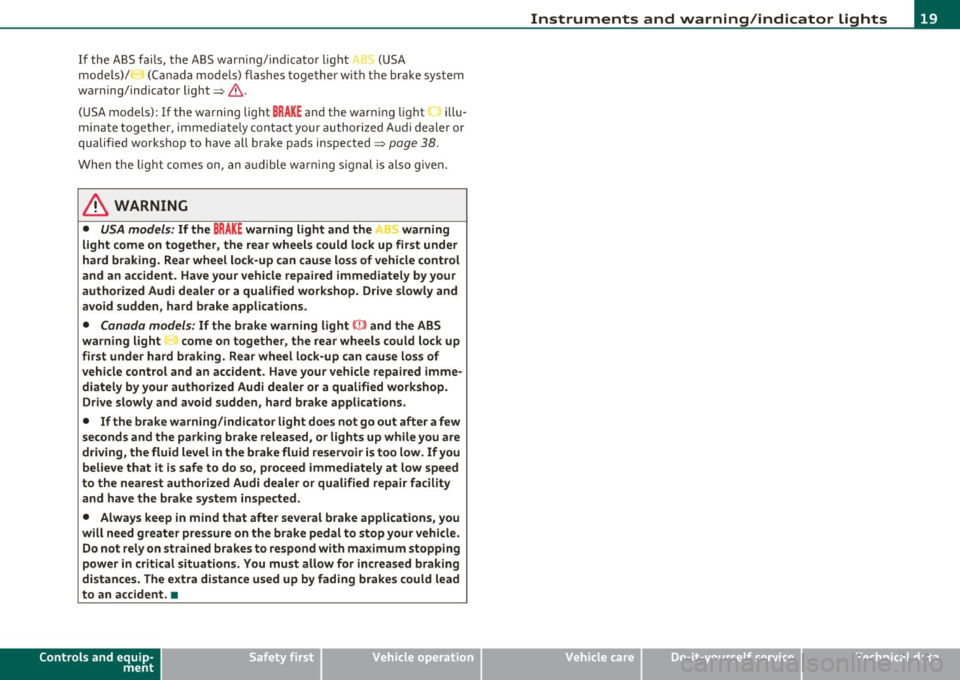
If the ABS fails, the ABS warning/indicator light ~r (USA
mode ls)/ (C anada mode ls) flashes toge ther w ith the br ake system
wa rning/ind icator light=> &.
(USA models): If the warning light
BRAKE and the warning light i llu
m inate together, immed ia te ly co ntac t your author ized A udi deale r or
qualified workshop to have all brake pads inspected=>
page 38.
When the light comes on, an a ud ible w arni ng s ign al is also given.
& WARNING
• USA model s: If the BRAKE warning light and the S warning
light come on togethe r, the rear wheels could lock up first under
hard braking . R ear wheel lock-up can cause lo ss of vehicle control
and an accident. Ha ve your vehicle repa ired immediately by you r
authorized Audi dealer or a qualified work shop. Driv e slowly and
avoid sudden , hard brake applications.
• Canada model s: If the brake warning light(@ and the ABS
warning light ,. come on togethe r, the rear wheels co uld lock up
first under hard braking. Rear wheel lock-up can cau se lo ss of
veh icle cont rol and an accident . Have your vehicle repaired imme
diately by your authorized Audi dealer or a qualified workshop.
Drive slow ly and avoid sudden, hard brake applications .
• If the brake warning/indicator light doe s not go out after a few
seconds and the parking brake released, or lights up while you are
driving , the fluid level in the brake fluid rese rvoir is too low. If you
believe that it is safe to do so, proceed immediately at low speed
to the neare st authorized Audi dealer or qualified repair facility
and have the brake system inspected .
• Always keep in mind that after several brake applications , you
will need greater pressure on th e brake pedal to stop your vehicle .
Do not rely on strained brakes to respond with maximum stopping
power in critical situation s. You must allow for increased braking
distances. The extra distance used up by fading brakes could lead
to an accident . •
Controls and equip
ment Safety first
Instruments and warning
/indicator lights
Vehicle care Technical data
Page 40 of 362
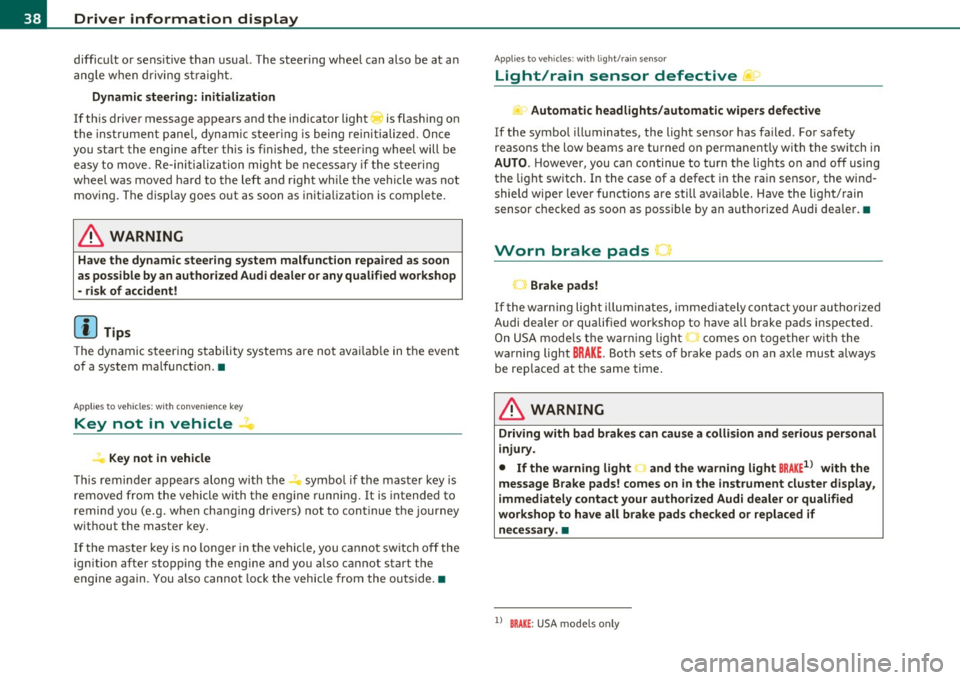
Driver information display
difficult or sensitive than usual. The steering wheel can also be at an
angle when driving straight.
Dynamic steering: initialization
If this driver message appears and the indicator light is flashing on
the instrument panel, dynamic steering is being reinitialized. Once
you start the engine after this is finished, the steering wheel will be
easy to move. Re-initialization might be necessary if the steering
wheel was moved hard to the left and right while the vehicle was not
moving. The display goes out as soon as initialization is complete.
& WARNING
Have the dynamic steering system malfunction repaired as soon
as possible by an authorized Audi dealer or any qualified workshop
- risk of accident!
rn Tips
The dynamic steering stability systems are not available in the event
of a system malfunction. •
Applies to vehic les: with con ven ie nce ke y
Key not in vehicle
Key not in vehicle
This reminder appears along with the 7 symbol if the master key is
removed from the vehicle with the engine running. It is intended to
remind you (e.g. when chang ing drive rs) not to continue the journey
without the master key.
If the master key is no longer in the vehicle, you cannot switch off the
ignition after stopping the engine and you also cannot start the
engine again. You also cannot lock the vehicle from the outside. •
App lies to veh icles : with light/ra in senso r
Light/rain sensor defective )
...i-Automatic headlights/automatic wipers defective
If the symbol illuminates, the light sensor has failed . For safety
reasons the low beams are turned on permanently with the switch in
AUTO. However, you can continue to turn the lights on and off using
the light switch. In the case of a defect in the rain sensor, the wind
shield wiper lever functions are still available. Have the light/ rain
sensor checked as soon as possible by an authorized Audi dea ler. •
Worn brake pads J
Brake pads!
If the warning light illum inates, immediately contact your authorized
Audi dealer or qualified workshop to have all brake pads inspected .
On USA models the warning light comes on together with the
warning light
BRAKE . Both sets of brake pads on an axle must always
be replaced at the same time.
& WARNING
Driving with bad brakes can cause a collision and serious personal
injury.
• If the warning light and the warning light
BRAKE1> with the
message Brake pads! comes on in the instrument cluster display,
immediately contact your authorized Audi dealer or qualified
workshop to have all brake pads checked or replaced if
necessary. •
l) BRAK£: USA mode ls only
Page 118 of 362

lffll..__O_ n_ t_h _e_ r_o _ a_ d _________________________________________________ _
& WARN ING (con tinu ed)
• For safety rea sons , y o u should alwa ys park your vehicle with
the selector lever in P . Otherw ise, the vehicle could inadvertently
roll
away.
• After the engine has been switched off, the radiator fan can
continue to run for up to 10 minutes -even with the ign ition
switched off.
It can al so switch on again after some time if the
c oolant tempe rature rises as the result of a heat buildup o r if the
engine i s hot and the engine compartment is additionally heated
by the sun 's rays.
0 Note
If the eng ine has been under heavy load for an extended per iod, heat
build s up i n the engine comp artment afte r the engine is swi tched off
- there is a risk of damaging t he engine. Allow the engine to run at id le
for about 2 m inutes befo re swi tc h ing it off. •
Electromechanical parking brake
Operation
The ele ctromechanical parking bra ke re places the hand
brake.
Fig. 1 09 Center
c o ns ole: P arki ng bra ke
- Pull o n the switc h@ ~ fig . 109 to app ly the parking
brake . The ind icator ligh t in the switc h illu minates.
- Step o n the brake pedal or the accelerator pedal a nd press
t he swit ch at the same ti me to release t he parking brake.
T he indicator lig ht in th e swi tc h go es o ut.
Your vehicle is equ ip ped with an e lectromechanical pa rking bra ke.
The parking brake is designed to prevent the vehicle from rol ling
unintentio nally and rep laces t he ha nd b rake.
In addit ion to the normal functions of a traditional hand brake, the
elect romecha nica l par kin g brake provides various convenience and
safety functions .
When starting from rest
• The integral start ing assist helps you when driving by automat i
cally re leas ing the parking bra ke =>
page 11 7, "Starting from res t".
• When starting on inclines, the sta rting assist prevents the vehicle
from uninten tionally ro llin g back. The br aking f orce of the par king
brake is not released unti l suff icient dr iving force has been built up at
t he whee ls.
Emergency brake function
An e mergency b rake ens ures t hat the vehicle can be sl owed down
even if the
normal brakes fail=> page 118, "Emergency bra kin g" .
Indicator lights
• If the park ing brake is closed w ith the ign it io n switched on the
indic ator lig hts come on
::'fa (USA models)/ © (Can ada models) in the
instrument cluster and the switch.
• If the park ing b rak e is closed with the ign it io n switched off the
indicator lights come on ::':. (USA models)/ © (Canada models) in the
in st rum ent cl ust er and the swit ch for abou t 20 se conds. ._
Page 122 of 362
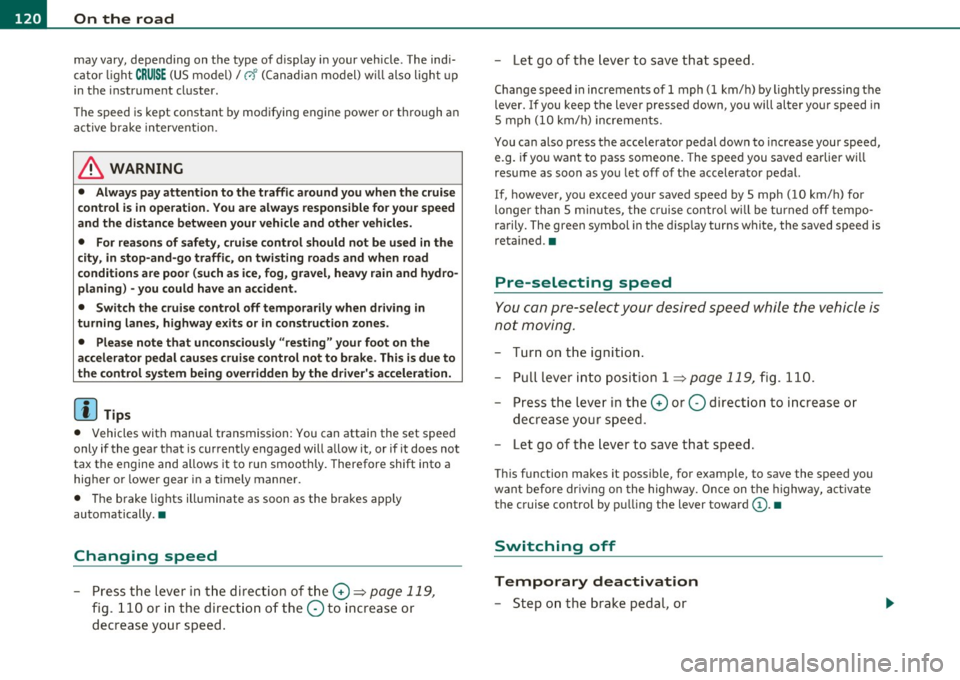
lffl!I.___O_ n_ t_h_ e_ r_ o_ a _ d _________________________________________________ _
may vary, depending on the type of display in your vehicle. The indi
cator ligh t
CRUISE (US model)/ 0" (C anadia n mo del) w ill also light up
in the instrume nt cluster .
The speed is kept constant by modifying engine power or through an
active brake intervention.
& WARNING
• Always pay attention to the traffic around you when the cruise
control is in operation . You are always responsible for your speed
and the distance between your vehicle and other vehicles.
• For reasons of safety, cruise control should not be used in the
city, in stop-and-go traffic, on twisting roads and when road
conditions are poor (such as ice, fog , gravel, heavy rain and hydro
planing) -you could have an accident.
• Switch the cruise control off temporarily when driving in
turning lanes, highway exits or in construction zones.
• Please note that unconsciously "resting" your foot on the
accelerator pedal causes cruise control not to brake. This is due to
the control system being overridden by the driver's acceleration.
(I) Tips
• Vehicles with manual transmission: You can attain the set speed
only if the gear that is currently engaged will allow it, or if it does not
tax the engine and allows it to run smoothly. Therefore shift into a
hig her o r lower gear in a t imely manne r.
• The brake lights illuminate as soon as the brakes apply
automatically .•
Changing speed
- Press the lever in the direction of the 0 => page 119,
fig. 110 or in the dire ction of the Oto increase or
decrease your speed . -
Let go of the lever to save that speed.
Change speed in increments of 1 mph (1 km/h) by lightly pressing the
lever. If you keep the lever pressed down, you will alter your speed in
S mph
(10 km/h) increments.
You can also press the accelerator pedal down to increase your speed,
e.g. if you want to pass someone. The speed you saved earlier will
resume as soon as you let off of the accelerator pedal.
If, however, you exceed your saved speed by 5 mph
(10 km/h) for
longer than 5 minutes, the cruise control will be turned off tempo
rarily. The green symbol in the d isp lay turns white, the saved speed is
reta ined. •
Pre-selecting speed
You can pre -select your desired speed while the vehicle is
not moving.
- Turn on the ign ition .
- Pull lever into position 1
:::> page 119, fig. 110.
- Press the lever in the
0 or O direction to increase or
decrease your speed.
- Let go of the lever to save that speed.
This function makes it possible, for example, to save the speed you
want before dr iv ing on the highway. Once on the highway, activate
the cruise control by pulling the lever toward
(D . •
Switching off
Temporary deactivation
- Step on the brake pedal, or
Page 125 of 362
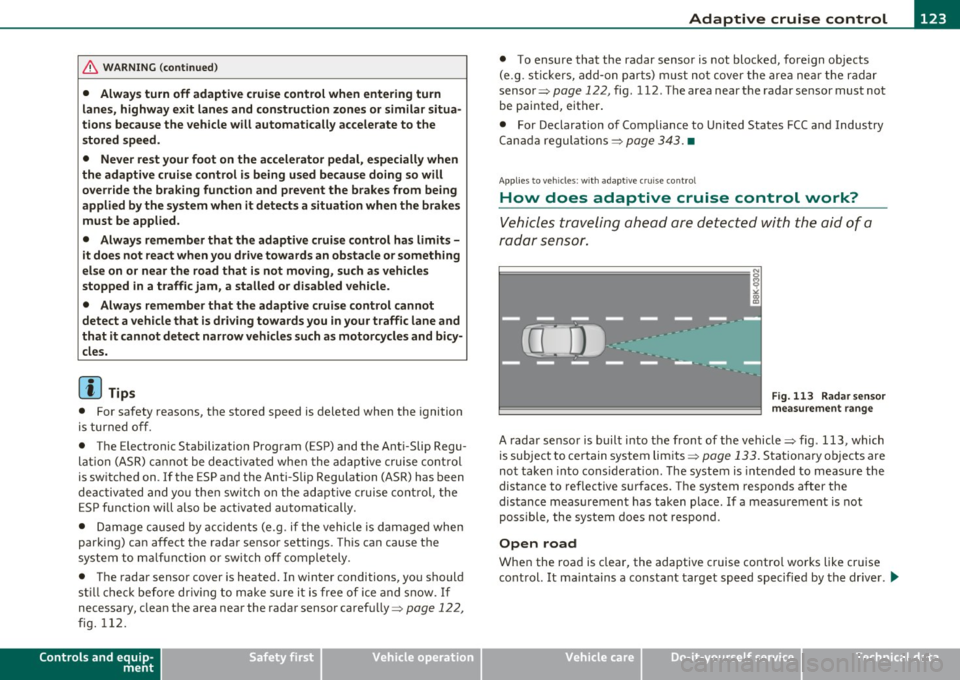
Adaptive cruise control -____________ __._ __ _
& WARNING (co ntinued )
• Always turn off adaptive crui se control when entering turn
lanes, highway ex it lanes and con struction zones or similar situa
tions because the vehicle will automatically accele rate to the
stored speed .
• Never rest your foot on the accelerator pedal, especially when
the adaptive cruise control is being u sed because doing so will
override the braking function and prevent the brakes from being
applied by the system when it detect s a situation when the brake s
must be applied.
• Alway s remember that the adaptive cruise control has limits -
it does not react when you drive towards an obstacle or something
else on or near the road that is not moving, such as vehicles
stopped in a traffic jam , a stalled or disabled vehicle .
• Always remember that the adaptive cruise control cannot
detect a veh icle th at i s driving towards you in your traffic lane and
that it cannot detect narrow vehicles such as motorcycles and bicy
cles .
[ i] Tips
• For safety reasons, the stored speed is deleted when the ignition
is turned off.
• The Electronic Stabilization Program (ESP) and the Ant i-Slip Regu
la tio n (A SR) c anno t be de activated when the adaptive cruise cont rol
is sw itched on .
If the ESP and the Anti -S lip Regulation (ASR) has been
de activ at ed an d yo u the n switch on the ad apt ive cruise cont rol, the
ESP fu nction w ill also be activated automatically.
• Dam age cau sed by accide nts (e.g. if the vehicle is dam age d whe n
park ing) can affect the rada r sensor settings. This can cause t he
sys tem to malfunc tion or switch off comple tely.
• The radar sensor cover is heated. In w inter conditions, you should
st ill ch eck befor e dr iv in g to make s ure i t is free of ice and s now. If
necessary, clean the area nea r the rada r sensor carefully=>
page 122,
fig. 112 .
Controls and equip
ment Safety first
•
To ensure that the radar sensor is not blocked , fore ign objects
(e .g. st ickers, add -on par ts) m ust no t cover the are a ne ar th e radar
sensor=>
page 122, fig . 112 . The area near t he radar sensor must not
be painted, either .
• For Declaration of Compliance to United States FCC and Industry
C an ada regula tions =>
page 34 3. •
App lies to ve hicle s: with adap tiv e crui se contro l
How does adaptive cruise control work?
Vehicles traveling ahead are de tec ted w ith the aid of a
ra dar sens or.
I;= =;. =============== -.~
~
ll!
Fig. 113 Radar sen sor
mea sureme nt r an ge
A radar sensor is buil t into the front of the vehicle=> fig. 113, which
is subject to ce rtain system limits =>
page 133 . Stationary o bjects are
not taken into cons iderat ion. The system is intended to measure the
distance to reflective s urfaces. The system responds after the
dis tance measuremen t has taken place. If a meas urement is not
poss ible, the system does not respond.
Open road
When the road is clear, the adaptive c ruise contro l works like cr uise
cont rol. It ma inta ins a constant target speed specified by the drive r.
~
Vehicle care Technical data
Page 126 of 362
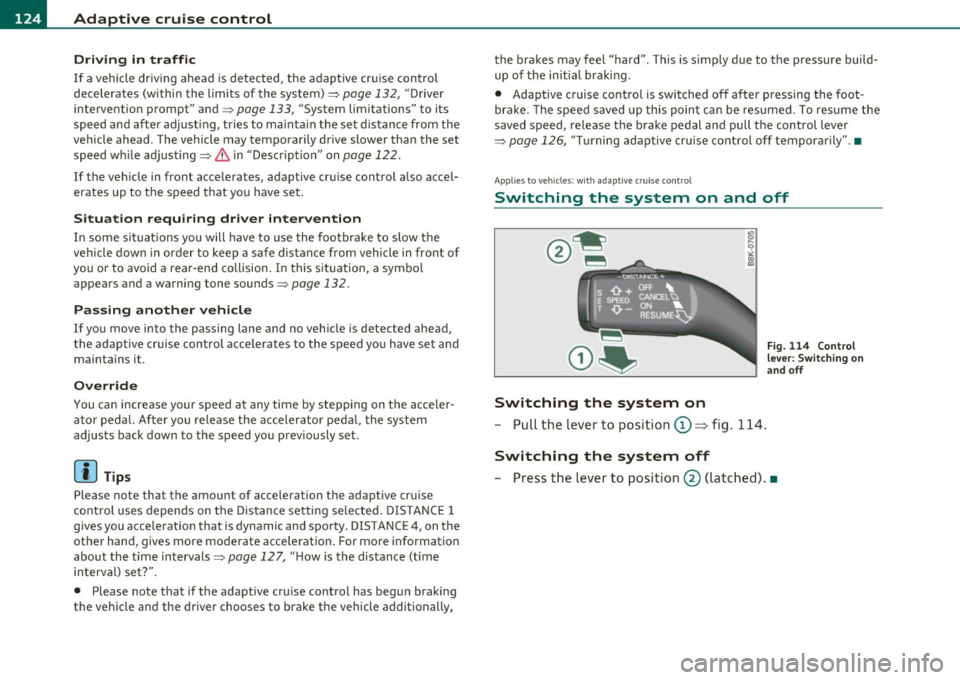
1111....__A_ d_ a..:.p _ t_ i _v _ e_ c_ r _u _ is_ e_ c_o _n_ t_r _o _l _____________________________________________ _
Driving in traffic
If a vehicle driving ahead is detected, the adaptive cruise control
decelerates (within the limits of the system)=>
page 132, "Driver
intervention prompt" and=>
page 133, "System limitations" to its
speed and after adjusting, tries to mainta in the set distance from the
vehicle ahead. The vehicle may temporarily drive slower than the set
speed wh ile adjusting::::>
& in "Description" on page 122 .
If the vehicle in front accelerates, adaptive cruise control also accel
erates up to the speed that you have set.
Situation requiring driver intervention
In some situations you will have to use the footbrake to slow the
vehicle down in order to keep a safe distance from vehicle in front of
you o r to avoid a rear-end co llision. In this situation, a symbo l
appears and a warning tone sounds=>
page 132.
Passing another vehicle
If you move into the passing lane and no vehicle is detected ahead,
the adaptive cruise control accelerates to the speed you have set and
maintains it .
Override
You can increase your speed at any time by stepping on the acceler
ator pedal. After you release the accelerator pedal, the system
adjusts back down to the speed you previously set .
[ i] Tips
Please note that the amount of acceleration the adaptive cruise
control uses depends on the Distance setting selected. DISTANCE 1
gives you accelerat ion that is dynamic and sporty. DISTANCE 4, on the
other hand, gives more moderate acceleration . For more information
about the time intervals=>
page 127, "H ow is the distance (time
interval) set?".
• Please note that if the adaptive cruise control has begun braking
the vehicle and the driver chooses to brake the vehicle additionally, the brakes may
feel "hard". This is simply due to the pressure build
up of the initial braking.
• Adaptive cruise contro l is switched off after pressing the foot
brake. The speed saved up this point can be resumed. To resume the
saved speed, release the brake pedal and pull the control lever
=>
page 126, "Tu rning adaptive cruise control off temporarily". •
Applies to veh icles : wit h ad aptive c ru is e cont rol
Switching the system on and off
Switching the system on
- Pull the lever to position 0 => fig. 114.
Switching the system off
Fig . 114 Control
lever: Switching on
and off
- Press the lever to position@ (latched) .•
Page 133 of 362
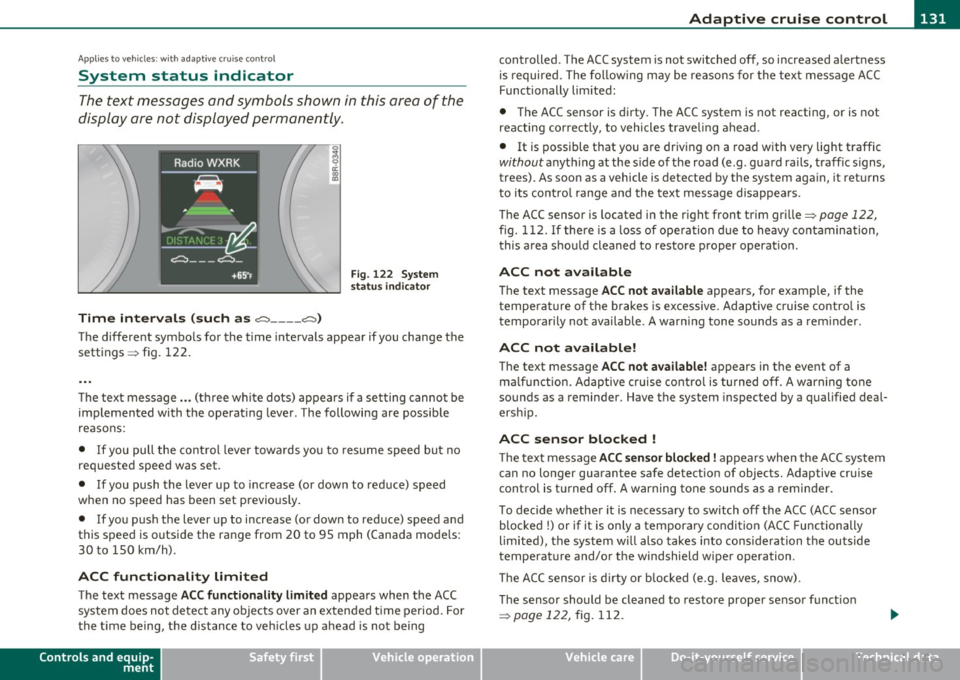
Adaptive cruise control -____________ __,:_ __ _
Appli es to ve hicl es: wi th a daptive cruise cont rol
System status indicator
The text messages and symbols shown in this area of the
display are not displayed permanently .
Time intervals (such as e::::, ____ e::::,)
Fig. 122 System
status indicator
The different symbols for the time intervals appear if you change the
sett ings => fig. 122 .
Th e text message ... (three white dots) appears if a setting cannot be
implemented with the operating lever. The following are possible
reasons:
• If you pull the control lever towa rds you to resume speed but no
requested speed was set .
• If you push the lever up to increase (or down to reduce) speed
when no speed has been set previously.
• If you push the lever up to increase (or down to reduce) speed and
this speed is outside the range from 20 to 95 mph (Canada mode ls:
30 to 150 km/h) .
ACC functionality Limited
The text message ACC functionality limited appears when the ACC
system does not detect any objects over an extended time period. For
the time being, the distance to veh icles up ahead is not being
Controls and equip
ment Safety first
controlled
. The ACC system is not switched off, so increased alertness
is required. The following may be reasons for the text message ACC
Functionally limited:
• The ACC sensor is dirty. The ACC system is not reacting, or is not
reacting correctly, to vehicles traveling ahead.
• It is possible that you are driving on a road with very light traffic
without anything at the s ide of the road (e .g . guard rails, traff ic s igns,
trees). As soon as a vehicle is detected by the system again, it returns
t o its contro l range and the text message disappears.
The ACC sensor is located in the r ight front trim grille=>
page 122,
fig. 112. If there is a loss of operation due to heavy contamination,
this area should cleaned to restore proper operat ion .
ACC not available
The text message ACC not available appears, for examp le, if the
t empe rature of the brakes is excessive. Adaptive cruise control is
temporarily not available. A warning tone sounds as a rem inder .
ACC not available!
The text message ACC not available! appears in the event of a
ma lf unct ion. Adaptive cruise control is turned off. A warn ing tone
sounds as a reminder . Have the system inspected by a qualified deal
ersh ip.
ACC sensor blocked !
The text message ACC sensor blocked! appears when the ACC system
can no longer guarantee safe detection of objects. Adaptive cruise
control is turned off. A warning tone sounds as a reminder.
To decide whether it is necessary to switch off the ACC (ACC sensor
blocked
!) or if it is only a temporary condition (ACC Functionally
limited), the system w ill also takes into consideration the outside
temperature and/or the windshield wiper operation .
Th e ACC sensor is d irty or blocked (e.g. leaves, snow).
The sensor should be cleaned to restore prope r sensor funct ion
=>
page 122, fig. 112.
Vehicle care Technical data
Page 136 of 362
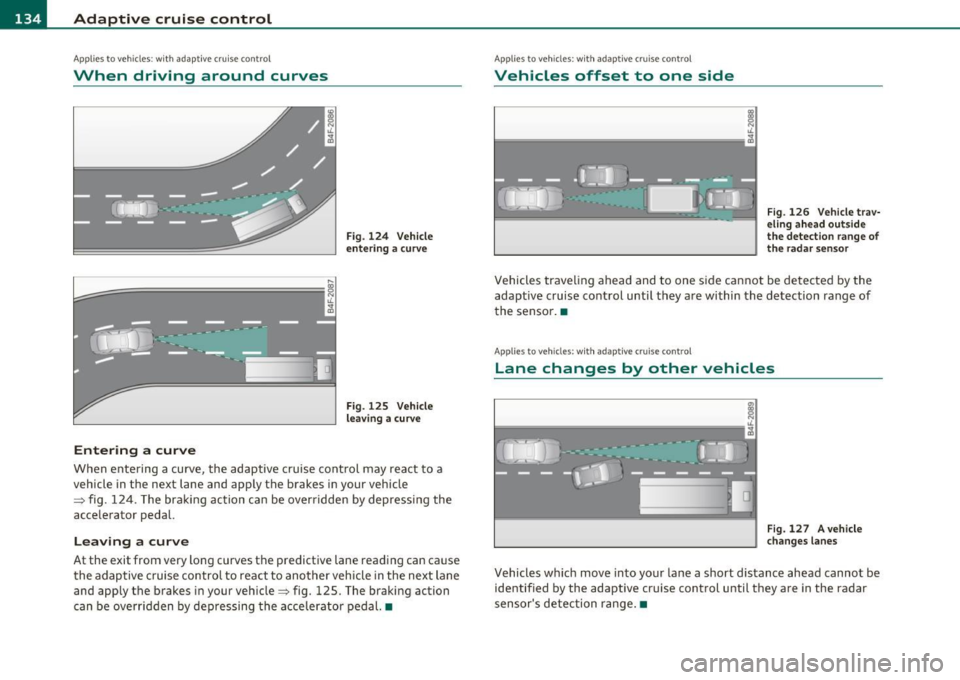
ffl..__A_ d_a_ p ::...... t_iv _ e_ c_r _u _i_ s _e _ c_o _n_ t_ r _o_ l ___________________________________________ _
Applie s to vehicles : w ith a daptiv e cr uise co ntrol
When driving around curves
.....
k;;;;:;;;;;;;;;;:;;:;========= =;J
o!i
.J
Entering a curve
Fig. 124 Vehicle
entering a curve
Fig. 125 Vehicle
leaving a curve
When entering a curve, the adaptive cruise control may react to a
vehicle in the next lane and apply the brakes in your vehicle
=> fig. 124. The braking action can be overridden by depressing the
accelerator pedal.
Leaving a curve
At the exit from very long curves the predictive lane reading can cause
the adap tive cruise control to react to another vehicle in the next lane
and apply the brakes in your vehicle => fig. 125. The braking action
can be overridden by depressing the accelerator pedal.•
Appli es to v eh icles : wi th adaptive cru is e co ntro l
Vehicles offset to one side
Fig. 126 Vehicle trav
eling ahead outside
the detection range of
the radar sensor
Vehicles traveling ahead and to one s ide cannot be detected by the
adaptive cruise control until they are within the detection range of
the sensor. •
Appli es to veh icle s: wit h ad aptiv e cruise cont rol
Lane changes by other vehicles
Fig. 127 A vehicle
changes lanes
Vehicles wh ich move into your lane a short distance ahead cannot be
identified by the adaptive c ruise control until they are in the radar
sensor's detec tion range. •